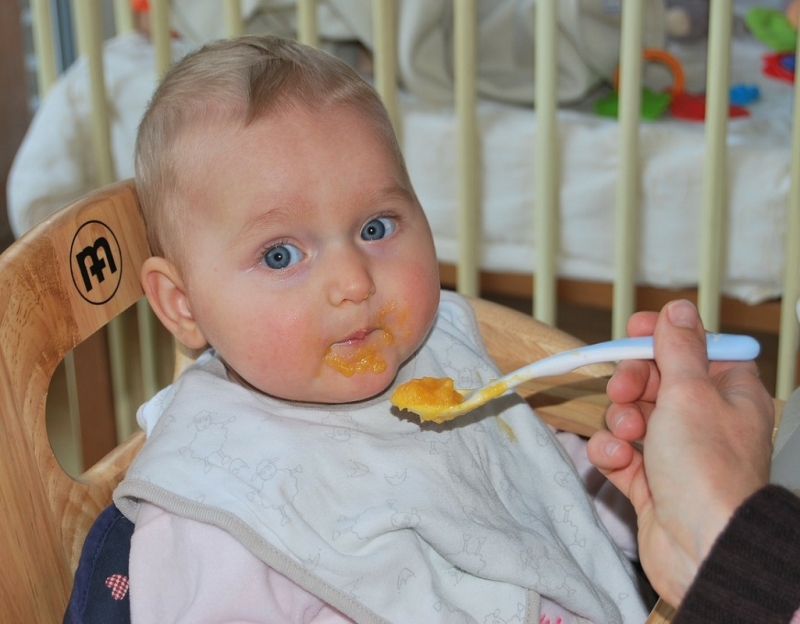Understand the difference between choking and gagging
Many babies gag as they learn to regulate the amount of milk or solid food they are swallowing – but there is a big difference between gagging and choking. Learning to recognise the difference will make mealtimes more relaxed.
The gag reflex automatically closes off the throat and pushed the tongue to the front of the mouth. It’s a reflex we have for our whole lives and is similar to the swallow, sneeze and cough reflexes. Your baby may gag a lot when you first introduce solid food – and later finger food – to her diet as she learns to regulate the amount of food she can manage to chew and swallow at one time. And much like adults, she is also likely to gag when she tastes food she doesn’t like.
If your baby gags, it will be a temporary situation and will resolve itself naturally and quickly. Some very young babies seem to gag a lot on their own spit – this is because babies tend to have excess mucous in their throat and the gagging reflex removes it so that their airway remains clear.
Choking occurs when the airway becomes blocked and prevents breathing. Generally, if your baby chokes, she will start to cough in an effort to dislodge the blockage. Soft foods are usually easily brought back up to the mouth with coughing but hard foods or other objects like small toys may require some additional help to dislodge.
IMPORTANT!
The key to effectively dealing with a choking incident is to stay calm. It is likely that your child will be able to dislodge the obstruction herself but this will be an upsetting incident for her – and you – and if you panic, you will only upset her further.
Choking first-aid
- Check to see if your baby coughing, crying or breathing.
- Monitor your baby if she is coughing as she may dislodge the obstruction on her own this way
- DO NOT hit your baby on her back in an effort to dislodge the obstruction
- DO NOT try to dislodge the obstruction by putting your fingers down her throat – this may just push the object further down the throat
- If breathing becomes laboured at any stage, seek medical assistance immediately.
Babies under 12 months:
- To assist a choking baby less than 12 months old, lie her face down over your lap, ensuring her head is lower than her chest, and then give her five firm blows between the shoulder blades using the heel of your hand. Check her mouth after each blow for the dislodged object.
- If she is still choking, lie her on her back on a firm surface and, using two fingers, give her five chest thrusts in the centre of her chest, checking after each for the dislodged object.
- If the object is still lodged, alternate between back blows and chest thrusts until emergency help arrives.
Children older than 12 months:
- Bending your child over so that her head drops towards her chest, give a sharp back blow between the shoulder blades using the heel of your hand. Repeat up to five times, checking between back blows for the dislodged object.
- If after five back blows, the object is still obstructing the airway put one hand on your child’s back and the other in the centre of her chest. Using the heel of your hand, give her five chest thrusts, checking each time for the dislodged object. Chest thrusts are similar to CPR compressions but are sharper and slower.
- If she is still choking, alternative back blows and chest compressions until emergency help arrives.
IMPORTANT!
If your baby or child becomes unconscious, start CPR immediately.
Avoiding choking hazards
- Never leave your baby unsupervised when she is eating or drinking from a bottle.
- Never let your baby or child eat while lying down
- Keep small toys and other objects out of reach of your crawling baby – babies can choke on anything that’s smaller than a D-size battery.
- Always cut food up into small pieces.
- The most common foods children under five years choke on are round-shaped and are sweets, grapes and nuts.
- Avoid sticky foods such as peanut butter while your child is small and learning to regulate the swallowing of solid food.
- Ensure that your child eats slowly, takes small mouthfuls of food and that she chews it thoroughly before swallowing.
- Never force your child to eat.
TIP!
Consider introducing finger foods such as fruit via a feeding mesh bag. These mesh bags hold the food safely inside while allowing your baby to access the food by chewing on the mesh which keeps pieces very small and manageable.
This article was written by Ella Walsh for Kidspot. Sources include St John Ambulance Australia and Vic Governement’s Better Health Channel.







Leave A Comment
You must be logged in to post a comment.